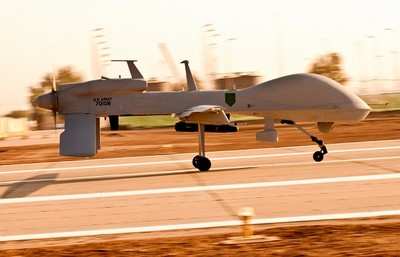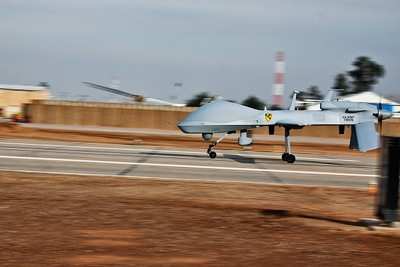One Of Two Deployed Army Units Currently Flying The Gray
Eagle
An Army unit deployed to Camp Taji, Iraq, is shaping the future
of the Army's unmanned aircraft systems program with a handful of
its newest aircraft, the MQ-1C Gray Eagle.

U.S. Army Photo
The unit, known as Quick Reaction Capability 1-Replacement 1,
deployed in June to use the Gray Eagle in combat before the Army
fields the aircraft to all of its aviation brigades in the next few
years. It is one of two deployed Army units currently flying the
Gray Eagle, and it is the only one using it in Iraq. The unit is
attached to the Enhanced Combat Aviation Brigade, 1st Infantry
Division, an all-in-one aviation brigade from Fort Riley, Kan. The
Gray Eagle's mission is similar to the mission of the brigade's
Apache and Kiowa helicopters, but as an unmanned aircraft, has
stronger ties to the intelligence community. The QRC1-R1 operators
are working with aviators from the brigade's Apache battalion to
integrate their mission into the aviation realm.
The Gray Eagle is an extended-range, multipurpose unmanned
aircraft designed primarily to provide ground commanders a set of
"eyes in the sky." The aircraft is built on the same platform as
the Air Force's Predator drone, and will provide the Army access to
the type of support usually provided by Predator-type aircraft.
"The Army needed more UAS support ... there was a gap in coverage,"
said Capt. Michael Goodwin, the unit's commander, and a native of
Cedar Island, N.C. "Predator-based platforms are spread too thin to
meet all of the Army's needs ... we're the Army's answer to finding
a quick solution to that problem."
The Army purchased its first batch of Gray Eagles from General
Atomics Aeronautical Systems while the aircraft was still in the
developmental stage. Forming the QRC units allowed the Army to get
a head-start on introducing the aircraft to combat. The unit has
not identified any significant flaws in the aircraft, which has
yielded impressive results during the first six months of
deployment, said Goodwin.

MQ-1C File Photo
The unit has flown nearly 7,000 accident-free hours, more than
350 combat missions, produced more than 16,000 surveillance-type
images, and maintained a systems operational readiness rate of
about 93 percent, according to unit reports. Soldiers of the QRC
unit are not only developing the Gray Eagle and its systems, but
often help introduce its technology to the commanders and ground
troops it is designed to benefit. "One of the biggest things we try
to do is educate other units about our capabilities," said Goodwin.
"A lot of units have the ability to use our assets, but they don't
know what we can do."
One of the most useful tools the unit offers ground troops is
education on a portable system known as the OSRVT, or One Station
Remote Viewing Terminal. Ground commanders using the system can
access the Gray Eagle's video feed from a laptop. The OSRVT can be
carried in a backpack and is designed to be used in most military
vehicles. Access to the Gray Eagle's feed through the system
provides ground commanders a firsthand, bird's eye view of the
battlefield, said Goodwin. "We're finding that a lot of units have
the OSRVT, but don't know what it does for them," he said. "Our
company helps train the ground guys on the system, on how to access
our feeds and use our aircraft to support them. It's such a new
technology that - just like our aircraft - most people don't know
how great the technology is. If I were a ground commander, I
wouldn't roll out without it."
In addition to the OSRVT, the Gray Eagle and its operators are
perfecting several technologies that are new to the Army's
spy-plane arsenal.

Older Army UAS platforms have typically only served as a
middle-man in engaging targets, providing attack helicopters,
planes, or ground troops with a target. With the Gray Eagle, the
Army's UAS family can now do both. The unit is working to prepare
the aircraft to carry hellfire missiles, and is scheduled to
conduct a live test of the missiles in Iraq during January. Sgt.
Brent Randal, a Gray Eagle operator deployed with QRC1-R1 and a
native of Las Vegas, NV, said that one of the aircraft's best
features is its new Synthetic Aperture Radar, or SAR. Mounted
underneath the Gray Eagle's nose, the SAR can compare
high-resolution images of a location taken at different times to
determine whether objects have been removed from or placed at a
scene. "Using the SAR we can fly by a site, fly by several hours
later, and if anything changes, we'll see it," said Randal.
The technology comes particularly useful in locating buried IEDs
and weapons caches, said Randal. The Gray Eagle can also help
ground troops communicate with their headquarters over long
distances. "We've had a couple situations where ground troops were
out of communications range from their higher headquarters, so we
used our radio systems in the aircraft to retransmit their signals
to their headquarters," said Randal. "In essence we bounce their
signal back to their base."
The Army plans to provide 12 Gray Eagles to each of its aviation
brigades when the aircraft is fully developed. The aircraft are
likely to work closely with the Army's scout helicopters, but will
remain strongly connected to intelligence and ground combat units,
officials said.
 ANN's Daily Aero-Term (04.24.24): Runway Lead-in Light System
ANN's Daily Aero-Term (04.24.24): Runway Lead-in Light System ANN's Daily Aero-Linx (04.24.24)
ANN's Daily Aero-Linx (04.24.24) Aero-FAQ: Dave Juwel's Aviation Marketing Stories -- ITBOA BNITBOB
Aero-FAQ: Dave Juwel's Aviation Marketing Stories -- ITBOA BNITBOB Classic Aero-TV: Best Seat in The House -- 'Inside' The AeroShell Aerobatic Team
Classic Aero-TV: Best Seat in The House -- 'Inside' The AeroShell Aerobatic Team Airborne Affordable Flyers 04.18.24: CarbonCub UL, Fisher, Affordable Flyer Expo
Airborne Affordable Flyers 04.18.24: CarbonCub UL, Fisher, Affordable Flyer Expo





